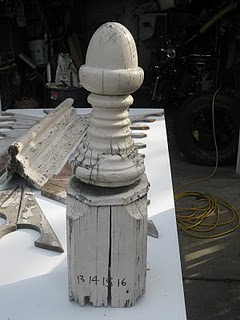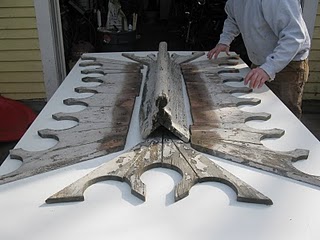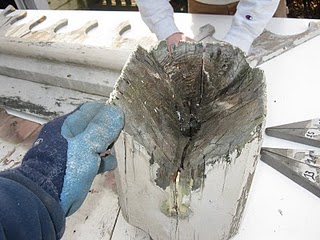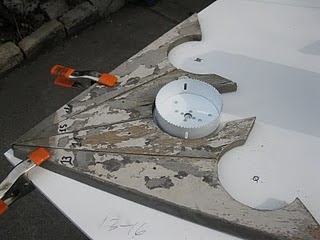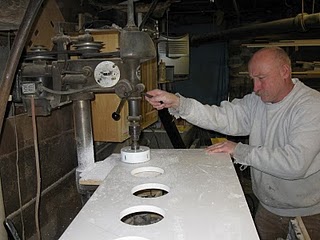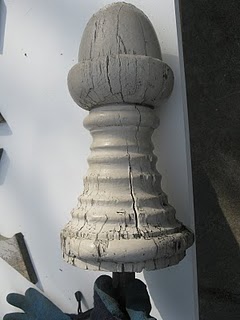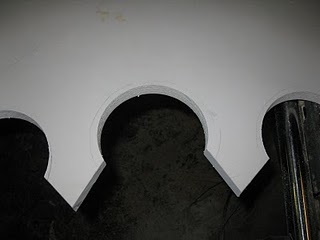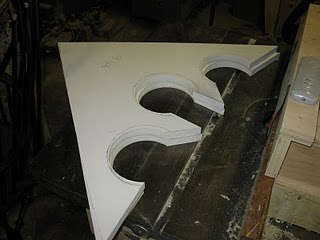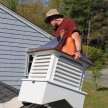Replacing An Acorn Roof Finial
Acorn Roof Finial
I worked on this Nashawtuc Road home back in 2008 when we replaced the front porch floor and installed a unique drainage system.
Recently the homeowner had the roof replaced. At the peak of the house’s hip roof sat a beautiful acorn shaped finial. This finial had been repaired many times over the past 100 years and was now a candidate for replacement. This finial is not easy to get to so the roofers took it down when re-roofing. This article is how we went about replacing an acorn roof finial.
The homeowner called me and asked if I would be willing to make him a new one. Unfortunately I do not have a BEFORE picture to show you. Trust me that it is a magnificent house and the finial was icing on the cake.
This homeowner is one of the best “old house” stewards I have ever met. We agonized about which materials to use and in the end opted for what we hope will be the best for aesthetics and longevity.
The roof top finial is in the shape of an Acorn. It also has an elaborate tail that sits on the roof ridge behind it, and fancy scroll skirting that sits on each side of the roof. [Acorn finial below and tail pictured to the left]
What is a Finial?
It is in simple terms the final means finish or the end of something. In architecture, a finial is a sculptured ornament, often in the shape of a leaf or flower, at the top of a buildings.
I was interested in what the acorn symbolized and did a brief search on it. Here’s what I found:
Acorns appear only on adult trees, and are often a symbol of patience and the fruition of long, hard labor. The oak tree is extremely hardy and many cultures have chosen the acorn to represent strength. It is also considered to be an emblem of luck, prosperity, youthfulness and power.
The oak tree and acorns have long been associated with many gods and goddesses. The acorn is the Celtic symbol for Zeus and the Roman symbol for Jupiter. Many Celtic and Roman goddesses, including Artemis and Diana, were frequently carved wearing acorn necklaces.
Below is the finial tail and skirting laid out on a table and numbered. When installed on the roof the skirting lays on the pitched roof and the tail sits on the roof peak or ridge.
The end view of the finial tail.
Close up of tail. This is a solid piece of wood. The 45 degree angled boards cover the decorative scroll skirting and provide weather / water coverage to the scroll skirt fasteners.
Below: end scroll / skirts, that sit on the hip side of the roof.
This is the bottom of the acorn base. It was hand cut and chiseled to fit snug on top of the hip roofs 3 sided edge.
The acorn finial was made of one solid piece of wood. The dowel at the bottom of it is part of this same piece of wood.
The dowel slid into a solid base and was locked in with two old fashioned nails through the base sides. A copper cap sat on the base in between the acorn finial to protect the end grain from water.
If you look closely the original carpenter curved the top of the base and made the bottom of the acorn concave. This allowed the two to fit snug together as well as shed water.
The entire assembly laid out.
Side view. Look closely at the turnings under the acorn. There is a lot of detail on this baby!
We had decided to make the scroll skirts out of one piece of material. PVC Azek was the winner of this choice because it takes the most beating on the roof.
The Acorn finial, base and tail will be made out of Spanish Cedar. To make the curves we used a 5″ hole saw in the drill press.
Bill Langton drilling the holes that will define the scroll skirting in his shop.
Holes complete – does not look like a scroll skirt does it? If you click to enlarge the picture you will see what looks like “X’s” Once we cut these lines the skirt points will be defined.
The acorn finial will be a fun project to make on the lathe.
Below: the dowel is actually part of the chunk of wood that makes up the acorn finial. If you look closely at my forefinger you can see the “heartwood” or center of the tree.
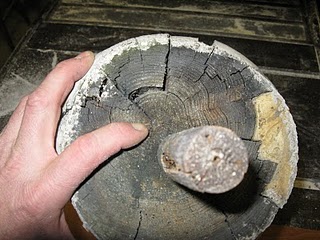 Final cuts made to the skirting define the points. Sanding is still needed to fine tune and shape the points.
Final cuts made to the skirting define the points. Sanding is still needed to fine tune and shape the points.



